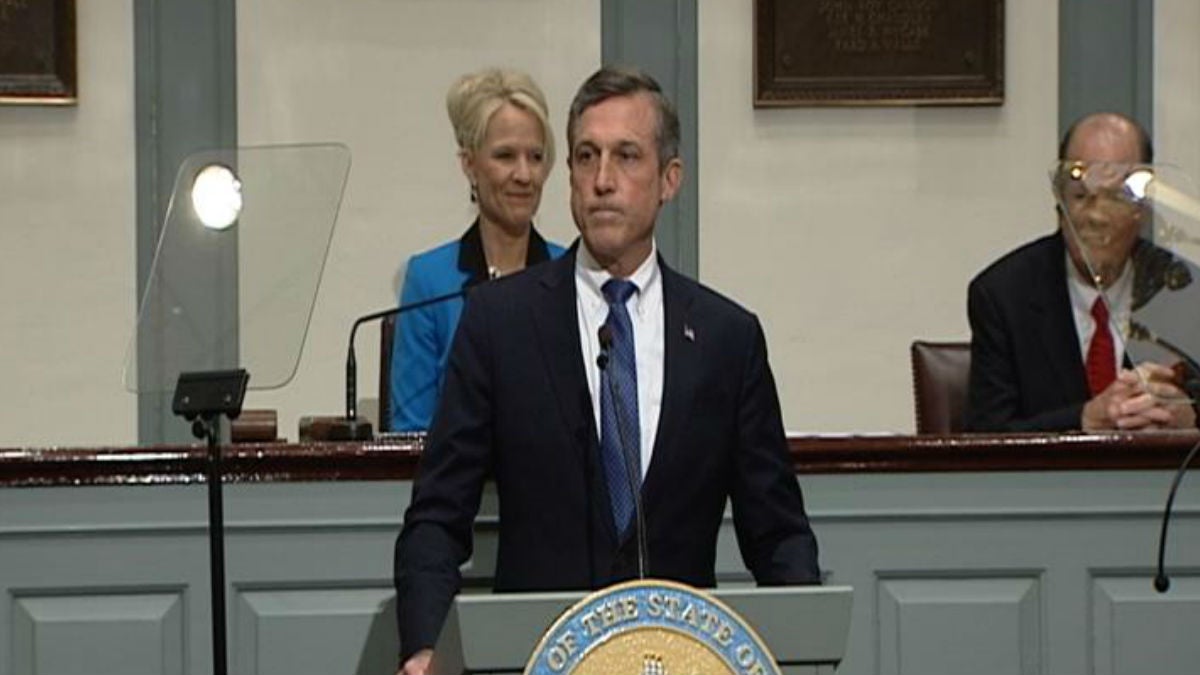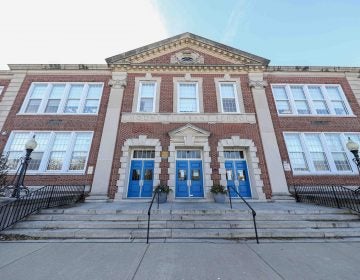Del. school districts preparing to get “slammed” by Carney’s proposed budget cuts
Listen
Delaware Gov. John Carney expounded on his budget plans during a speech Thursday to a joint session of the General Assembly. (Paul Parmelee/WHYY)
Many in Delaware’s education community have grave concerns about the loss of $37 million that now pays for teacher salaries and other school costs in the wake of Gov. John Carney’s proposed “shared sacrifice” budget.
Districts are bracing to get “slammed” by the proposed cuts, said the state teacher’s union president, adding that teachers and school support staff could be served with layoffs notices in May because officials won’t know whether they will be able to pay them next school year.
The Red Clay district’s superintendent says he is having sleepless nights as he grapples with whether to cut staff and programs, seek to raise tax rates, or a combination of both. Appoquinmink’s superintendent says Carney “has given us a seemingly Herculean task.”
Delaware’s Parent-Teacher Association chief worries that students, especially those from the poorest neighborhoods, won’t get services she says they so sorely need to prevent them from falling further behind academically.
School officials suspect they could lose reading and math specialists who work with low-performing students, or won’t be able to fill other vacancies. Such moves would lead to larger class sizes, making it harder to connect with students.
Intervention specialists who patrol the halls with two-way radios — a critical position in schools with disciplinary problems — could be eliminated. Many fear after-school educational and sports program could get axed. Perhaps schools won’t be able to invest in technology so critical to education today.
All fear repercussions from voters should they levy a so-called match tax to offset their share of $22 million Carney would pare from the Educational Sustainment Fund. Levying the match tax would only have to be approved by a school board – not district voters– and could jeopardize future attempts to raise money through a referendum that voters would decide.
Carney, a former state finance secretary, lieutenant governor and congressman who took office in January, unveiled his budget proposal last week and expounded on his plans during a speech Thursday to a joint session of the General Assembly. Lawmakers must approve a balanced budget by June 30.
Since his inauguration, Carney has frequently repeated that he must find ways to close a mammoth budget deficit for fiscal 2018 — a gap he said Thursday has grown to $400 million.
His general fund budget includes what he called a “50-50” mix of spending cuts and revenue hikes, including across-the-board increases in personal income tax rates and eliminating itemized deductions on tax forms in lieu of a standard deduction.
“If you are in a hole, the first thing you do is stop digging,” Carney told lawmakers Thursday.
Carney’s ‘budget reset’
Statewide this school year, Delaware is spending $2.3 billion in taxpayer dollars on K-12 public education.
The state pays about two-thirds of that money – $1.38 billion – but Delaware’s local districts are spending roughly $700 million and the federal government chips in $200 million.
The state’s $1.38 billion share this year represents 34 percent of Delaware’s $4.08 billion general budget. For fiscal 2018, which starts July 1, outgoing two-term governor Jack Markell proposed spending $1.45 billion – a more-than $70 million increase – on public education.
Markell’s increases included about $25 million needed to pay for new teachers, a figure mandated by law to meet Delaware’s ever-increasing enrollment.
There were 136,100 students in K-12 public schools last year, an increase of 14,200 students (12.5 percent) in the last 10 years. During that period, the number of Delaware students who attend private schools fell from 28,000 to 20,000 — a 28 percent drop.
Markell’s budget also proposed adding $7.9 million in early education funding. Carney wants to add money for early education, but only $4.7 million.
Those details were among the ones Carney unveiled March 22 in what he called his “budget reset” blueprint.
His proposal included providing a total $1 million in “opportunity grants” for schools statewide with high percentages of low-income students or those who require special instruction to communicate and learn in the English language.
That’s $6.5 million less than what was sought by the Wilmington Education Improvement Commission for city schools alone. Markell and state lawmakers formed the panel to help guide decisions on improving city schools.
In his address Thursday, the governor said he would to revamp the state Department of Education in ways he did not outline to better serve students. In an interview this week, Carney’s education secretary, Susan Bunting, also did not discuss reorganization plans.
Carney did not mention during his speech, however, cuts from two pots of money that total $37 million. The proposals:
Slash $22 million from the Delaware Education Sustainment Fund, leaving it with $6 million. Each district gets a percentage based on enrollment.
Cut $15 million from direct allocations to districts — 1.5 percent.
Cut $1 million from unspecified programs in the Department of Education.
The governor insisted, however, that the education of Delaware’s children, especially those in the most difficult situations, is paramount.
“Our dreams for our children’s future don’t disappear because of a budget crisis,” Carney said.
‘Herculean task’
District leaders said the $37 million Carney has proposed cutting is primarily used to pay the local portion of teacher salaries. The state pays the lion’s share of teacher’s salaries in both Red Clay and Appoquinimink districts, with districts paying the difference.
Since salaries and benefits for employees comprise at least 75 percent of spending in each school district, cuts would likely mean some teachers and programs could be eliminated, many education officials said.
Matt Burrows, superintendent of Appoquinimink School District in southern New Castle County and president of the Delaware Chief School Officer’s Association, issued a statement saying school leaders “understand that education has to do its part.”
Cutting $37 million, however, “will place great stress on Delaware’s public schools. The governor has given us a seemingly Herculean task – to try to determine what can be done to unpack the systems and services currently in place without negatively impacting students in the classroom.”
Burrows added that “we have some heavy lifting ahead and need to work strategically with teachers, school boards and legislators to determine the best way to address the challenge while continuing to deliver a quality education.”
Merv Daugherty, superintendent of the Red Clay Consolidated School District, the largest in Delaware with 16,100 students this year, said Carney’s proposals could cost his operation up to $5 million.
Daugherty said he and district financial and academic leaders are going through the $260 million budget line by line to figure out ways to “pinch everywhere” without cutting services substantially or laying off teachers. A hiring freeze will be implemented. “Everything for us is on the table,” Daugherty said.
But since the budget won’t be finalized for three months, Daugherty said he and other district leaders are uncertain just how much they will have to cut – or raise from district residents. “All this is doing is pushing the problem on to local funding,” he said.
Should district boards levy the match tax to recover the lost money, the risk the wrath of voters when they decide to have a referendum, Daugherty and others said.
“I’m concerned for what this could possibly be for staffing in our schools and class sizes,” Elizabeth Paige, board president for Christina School District. “But a major concern I share with many citizens is this idea of giving flexibility to raise taxes without referendum.”
Christina is already struggling with the loss of tens of millions of dollars in money because about 7,400 students — one-third — who live in the district have opted to attend public schools outside the district, charter schools within Christina boundaries or vocational-technical schools. Two years ago budget woes led the district to eliminate librarian jobs from the district’s six middle and high schools.
Paige said the looming cuts will make for “difficult conversations because already there’s hardly enough money to around for schools in our district. We’ll have to take a look at good programs across the district and make the best decisions with the least impact on students.”
‘Make the hard decisions’
Frederika Jenner, outgoing president of the Delaware State Education Association, initially said this week she didn’t think Carney’s proposals would cost teachers or other staffers their jobs.
The union represents not only teachers but many other school employees such as paraprofessionals, secretaries, janitors, cafeteria workers and bus drivers.
Union leaders were not surprised by the “shared sacrifice” philosophy of Carney, whom her union endorsed, Jenner said Tuesday. “We were very encouraged by the fact that the governor crafted this budget without cutting any educator jobs and we hope the school districts can do the same,” she said then.
But Wednesday, after reviewing the budget proposals further, Jenner contacted WHYY to “better clarify” her remarks. This time her tone was more of alarm. “Our districts are really getting slammed by this,” she said. “This is definitely going to mean loss of staff.”
Jenner said districts must- without the certainty of how much the cuts will ultimately be- ask their boards to approve staffing cuts so they can notify teachers by May 15 that their position is being eliminated. Layoff notices can always be rescinded, but Jenner said teachers and other educators, such as psychologists and librarians and counselors “will think nothing” about taking a position in a nearby state.
The damage to Delaware’s reputation in the education community could be severe, she said. “They might say, ‘The heck with this. Delaware’s economic picture doesn’t look too rosy,'” Jenner said. “The message is going to get out.”
Terri Hodges, Delaware PTA president, said her group is disappointed the governor has decided to cut money to districts and not invest more in the Wilmington schools with high poverty and low performance.
“When we start making cuts in public education what is happening is that we have students coming out of school and entering into our job market who are not prepared for the job, not prepared to fully function in our society,” she said. “It takes away from the economic development of our community.”
Atnreakn Alleyne, a former state education administrator who now runs Delaware Campaign for Achievement Now, a nonprofit education advocacy program, acknowledged that Carney’s cuts are “going to be painful.”
Given that the reality of budget restraints is about to hit home, Alleyne said it’s time for districts to “make the hard decisions” to eliminate or downscale programs that they can’t show are successful, using reliable data. Districts need to seriously consider “collaborating to find efficiencies” that can cut spending without sacrificing the needs of children.
“It puts a heightened focus on what’s working,” he said. “But if we don’t ask the questions around performance and what’s having the most impact and what is most useful, that’s going to be problematic.”
WHYY is your source for fact-based, in-depth journalism and information. As a nonprofit organization, we rely on financial support from readers like you. Please give today.




